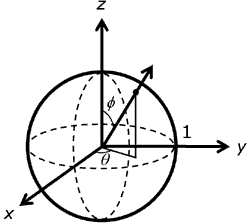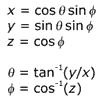Evaluates a directional light And returns spectral spherical harmonic (SH) data.
HRESULT D3DXSHEvalDirectionalLight( UINT Order, CONST D3DXVECTOR3 * pDir, FLOAT Radius, FLOAT RIntensity, FLOAT GIntensity, FLOAT BIntensity, FLOAT * pROut, FLOAT * pGOut, FLOAT * pBOut );
If the function succeeds, the return value is D3D_OK. If the function fails, the return value can be: D3DERR_INVALIDCALL.
The output vector is computed so that if the intensity ratio R/G/B is equal to 1, the resulting exit radiance of a point directly under the light on a diffuse object with an albedo of 1 would be 1.0. This will compute three spectral samples; pROut will be returned, while pGOut and pBOut may be returned.
On the sphere with unit radius as shown, direction can be specified simply with theta, the angle about the z-axis in the right-handed direction, and phi, the angle from z.

The following equations show the relationship between Cartesian (x, y, z) and spherical (theta, phi) coordinates on the unit sphere. The angle theta varies over the range of 0 to 2 pi, while phi varies from 0 to pi.

Header: Declared in D3dx9math.h.